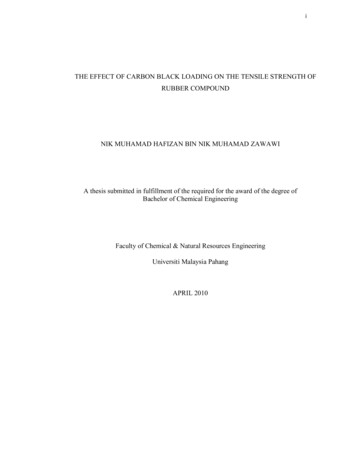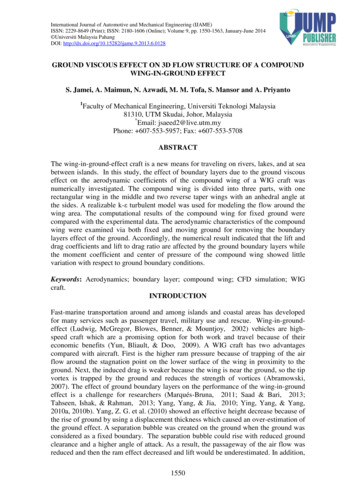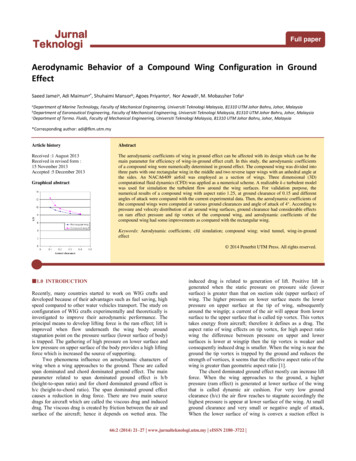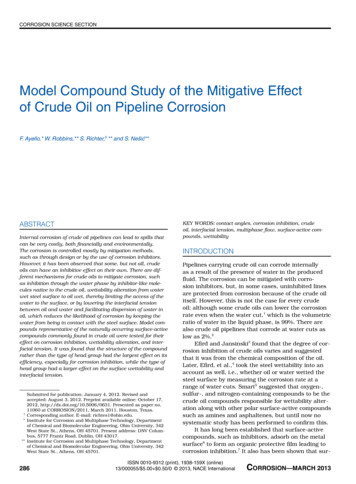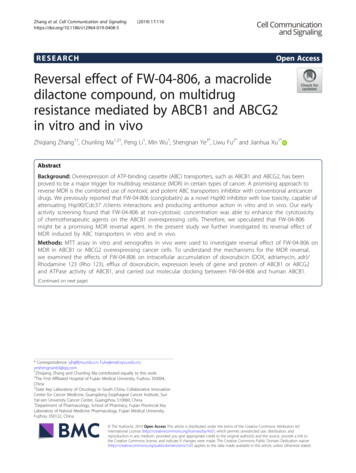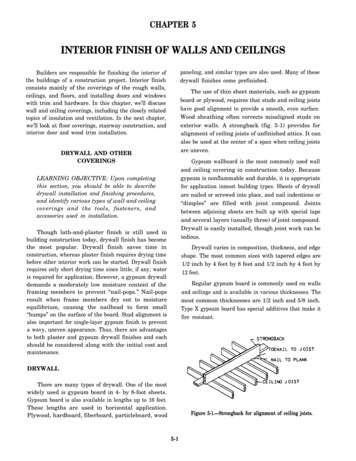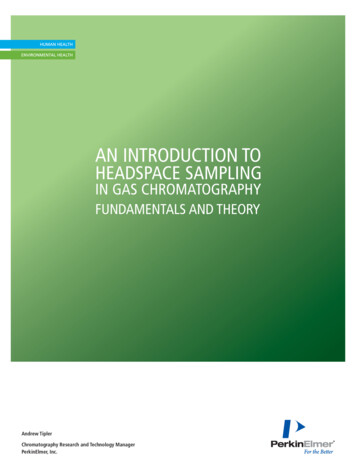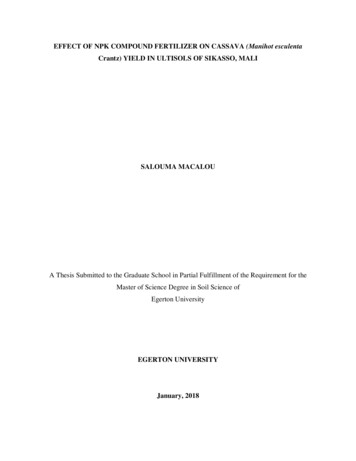
Transcription
EFFECT OF NPK COMPOUND FERTILIZER ON CASSAVA (Manihot esculentaCrantz) YIELD IN ULTISOLS OF SIKASSO, MALISALOUMA MACALOUA Thesis Submitted to the Graduate School in Partial Fulfillment of the Requirement for theMaster of Science Degree in Soil Science ofEgerton UniversityEGERTON UNIVERSITYJanuary, 2018i
DECLARATION AND RECOMMENDATIONDeclarationThis thesis is my original work and has not been presented before in this or any institution forany award of a degree.Signature: .Date: .Salouma MacalouKM13/14370/15RecommendationThis thesis is the candidate‟s original work and has been prepared with our guidance andassistance and is submitted with our approval as the official university supervisors.Signature: Date: Prof. Amos Musandu, Ph.DDepartment of Crops, Horticulture and SoilsEgerton UniversitySignature: .Date: .Prof. Samuel Mwonga, Ph.DDepartment of Crops, Horticulture and SoilsEgerton Universityii
COPYRIGHT 2018. Salouma Macalou.All rights are reserved. No part of this thesis may be reproduced, stored in any retrieval systemor transmitted in any form or any means, be it electronic, mechanical, photocopying, recording orotherwise without written permission of the author or Egerton University.iii
DEDICATIONI humbly dedicate this work to my beloved family, friends and employer whom I owe a lot tothe success. May God bless you in a mighty way.iv
ACKNOWLEDGEMENTI thank the all mighty God for given me the strength and the health to accomplish this masterprogram. I acknowledge Egerton University for given the chance to realize my dream. Myspecial acknowledgment goes to my supervisors Prof. Amos Musandu, and Prof. SamuelMwonga, of Egerton University Department of Crops, Horticulture and Soils for their tirelesssupport during this master program. The study was made possible by the generous support ofthe American people through the U.S. Agency for International Development (USAID-Mali)and Michigan State University through the Borlaug Higher Education for AgriculturalResearch and Development (BHEARD), l‟Institut d‟Economie Rurale (IER/Mali) for thesupport over my person and all those who contributed generously in one way or anothertowards my success. May God bless you all.v
ABSTRACTCassava is an important food crop grown across Mali which is cultivated on Ultisols inSikasso region situated in the southern part of the country. The lack of recommendedinorganic fertilizer is among the main constraints in cassava production in the country. TheN, P and K inorganic fertilization is not well practiced due to its high cost and no effectivefertilizer use packages. This study aimed at determining the effect of four NPK fertilizer (1515-15) rates (0kg, 100kg, 200kg and 300kg) ha-1 applications on the yield of two cassavagenotypes. The two genotypes, Bonima (local) and Sika (introduced from Ghana) were usedin a randomized complete block design (RCBD) experiment with three replicates in two sites,Finkolo and Loulouni during one rainy season. The fertilizer rates were applied in splits atequal quantity, two weeks after planting and the rest two months later. Analysis of soilnutrients before planting and plant N, P and K uptake were performed to assess the optimuminorganic fertilization rate for higher yield. Data on plant height, numbers of branches,number of stem, stem diameter, number of tubers by plant, fresh tuber weight, and yieldefficiency were collected. Data on cassava production input and output per hectare were alsocollected. Data collected were subjected to analysis of variance using Statistical AnalysisSystem (SAS version 9.3). The Least Significant Difference (LSD) at p 0.05 was used toseparate means. On cassava growth parameters, the higher NPK fertilizer rate which was 300kg ha-1 increased plant height by 29 and 27% compared to the one from 100 kg ha-1 and thecontrol plot respectively at 8 months after planting (MAP). The 300 kg ha-1 had increasedalso the cassava stem diameter by 25% compared to the control. On yield parameters, thenumber of tuber per plant and cassava fresh tuber yield increased by 49% and 133%respectively in plot which received 300 kg ha-1 of NPK. A correlation between NPKinorganic fertilizer rates and fresh tuber yield was determined. The number of branches perplant and number of tuber per plant were found to be strongly correlated. The agronomicNutrient use efficiency (NUE) was found to increase with additional NPK rates up to 300 kgha-1. The NPK inorganic fertilizer effect was significant on cassava leave phosphorus content.The leave content in nitrogen and potassium were influenced by site effect making Finkolomore favorable. The simple cost-benefit analysis revealed that cassava production is abeneficial activity in the study sites in Sikasso region. In Loulouni and Finkolo theapplication of 300 Kg ha-1 of inorganic NPK gave 1300.56 and 486.26 respectively whichwere the highest value of the net benefit from one hectare of cassava. These results will forma basis for NPK inorganic fertilizer recommendations in cassava production in Sikasso andpolicy brief in cassava production in the country.vi
TABLE OF CONTENTSDECLARATION AND RECOMMENDATION .iiCOPYRIGHT . iiiDEDICATION. ivACKNOWLEDGEMENT . vABSTRACT . viTABLE OF CONTENTS .viiLIST OF TABLES . xiLIST OF FIGURES .xiiLIST OF APPENDICES . xivLIST OF ACRONYMS AND ABBREVIATIONS . xvCHAPTER ONE . 1INTRODUCTION. 11.1 Background information . 11.2 Study limitation . 21.3 Statement of the problem . 21.4 Objectives . 31.4.1 General objective . 31.4.2 Specific objectives . 31.5 Hypotheses . 31.6 Justification . 3CHAPTER TWO . 5LITERATURE REVIEW . 52.1 Cassava production in Mali . 52.2 Cassava as food security crop . 52.3 Cassava cropping systems . 62.3.1 Monocropping . 6vii
2.3.2 Intercropping . 72.3.3 Rotation systems . 72.4 Constraints of cassava production in West African . 82.4.1 Soil fertility constraints . 82.4.2 Agro-ecological condition . 102.4.3 Pest and diseases . 112.4.4 Germplasm availability. 122.4.5 Other constraints . 122.5 Cassava as an industrial crop . 122.6 Adoptions of cassava improved varieties . 132.7 Cassava production and soil depletion . 132.7.1 Soil erosion . 132.7.2 Soil nutrient balance . 142.8 Media soil in cassava growing areas in Mali . 142.8.1 Ultisols . 142.8.2 Alfisols. 152.8.3 Aridisols. 16CHAPTER THREE . 17MATERIALS AND METHODS . 173.1 Experiment sites . 173.2Experimental design and treatment combination . 203.2.1 Experimental design . 203.2.2 Treatment combination . 203.2.3 Field layout . 213.3 Experiment procedure . 223.3.1 Land preparation and planting . 223.3.2 Management of trial. 22viii
3.4 Data collection. 233.4.1 Soil sampling and analyses . 233.4.2 Plant tissue sampling and analyses . 243.4.3 Plant growth and yield measurements . 243.4.4 Nutrient use efficiency. 243.4.5 Data for simple cost benefit analysis . 243.5 Data analysis . 253.6 Experimental model and expected means squares (EMS) . 25CHAPTER FOUR . 27RESULTS AND DISCUSSION . 274.1 Soil characteristics. 274.2 Effect of NPK fertilizer, genotype and site on cassava growth parameters . 284.2.1 Effect of NPK fertilizer on cassava growth parameters . 284.2.2 Effect of genotype on cassava growth parameters . 314.2.3 Effect of site on cassava growth parameters . 324.3 Effect of NPK fertilizer, genotype and site on cassava yield parameters . 364.3.1 Effect of NPK fertilizer on cassava yield parameters . 364.3.2 Effect of genotype on cassava yield parameters . 384.3.3 Effect of site on cassava yield parameters . 394.5 Correlation of cassava growth and yield parameters . 404.5 Regression of NPK fertilizer rates on cassava growth parameters and yield . 424.6 Cassava agronomic nutrient use efficiency . 484.7 NPK uptake in cassava plant leaves . 514.8 Simple cost benefit analysis . 534.8.1 Simple cost benefit analysis in Loulouni. 534.8.2 Simple cost benefit analysis in Finkolo . 54ix
CHAPTER FIVE . 56CONCLUSION AND RECOMMENDATION . 565.1CONCLUSION . 565.2RECOMMENDATION . 56REFERENCES: . 57APPENDICES . xiiix
LIST OF TABLESTable 1: Rainfall in the study areas (mm) during the study period . 19Table 2: Monthly temperature ( ºC ) mean in Sikasso during the experiment period . 19Table 3:Monthly mean relative humidity in Sikasso zone (%) during the experiment period 19Table 4: Experiment treatments combination . 21Table 5: Expected means square . 26Table 6: Chemical and physical properties of top and subsoil experimental site . 27Table 7: Effect of site on mean height of cassava plant . 33Table 8: Effect of site on mean number of cassava stems . 33Table 9: Effect on mean number of branches in cassava plants . 34Table 10: Effect of site on cassava stem mean diameter . 34Table 11: Effect of site by genotype interaction on cassava mean height . 35Table 12: Correlation of cassava growth parameters and yield in Loulouni . 41Table 13: Correlation of cassava growth parameters and yield in Finkolo . 42Table 14: Cost benefit in Loulouni . 54Table 15: Cost benefit in Finkolo . 54xi
LIST OF FIGURESFigure 1: Map of experimental sites . 18Figure 2: Field layout . 22Figure 3: Effect of NPK doses on cassava mean height . 29Figure 4: Effect of NPK fertilizer doses on the mean number of branches per plant in cassava. 30Figure 5: Effect of NPK fertilizer on cassava mean stem diameter . 31Figure 6: Effect of cassava genotype on mean plant height . 31Figure 7: Effect of genotype on mean number of branches in cassava . 32Figure 8: Effect of site by genotype interaction on cassava stem mean number . 35Figure 9: Effect of site by genotype interaction on cassava mean number of branches . 36Figure 10: Effect of NPK fertilizer on mean number of cassava tubers per plant . 37Figure 11: Effect of NPK fertilizer on mean cassava fresh tuber yield . 38Figure 12: Interaction effect of site by NPK fertilizer on cassava mean fresh tuber yield . 40Figure 13: Regression of Bonima genotype mean number of branches per plant and the fourNPK doses in Loulouni site . 43Figure 14: Regression of Sika genotype mean number of branches per plant and the four NPKdoses in Loulouni site . 43Figure 15: Regression of Bonima genotype mean yield and the four NPK doses in Loulounisite . 44Figure 16: Regression of Sika genotype mean yield and the four NPK doses in Loulouni site. 44Figure 17: Regression of Bonima genotype mean number of tuber/plant and the four NPKdoses in Loulouni site . 45Figure 18: Regression of Sika genotype mean number of tuber/plant and the four NPK dosesin Loulouni site . 45Figure 19: Regression of Bonima genotype mean number of branches per plant and the fourNPK doses in Finkolo site. 46Figure 20: Regression of Sika genotype mean number of branches per plant and the four NPKdoses in Finkolo site. 46Figure 21: Regression of Bonima genotype mean yield and the four NPK doses in Finkolosite . 47xii
Figure 22: Regression of Sika genotype mean yield and the four NPK doses in Finkolo site 47Figure 23: Regression of Bonima genotype mean number of tuber/plant and the four NPKdoses in Finkolo site. 48Figure 24: Regression of Sika genotype mean number of tuber/plant and the four NPK dosesin Finkolo site . 48Figure 25: Effect of NPK doses on Bonima and Sika nutrient use efficiency . 49Figure 26: Effect of NPK doses on nutrient use efficiency in Finkolo and Loulouni . 50Figure 27: Effect of site by NPK doses on nutrient use efficiency in Finkolo and Loulouni . 51Figure 28: Effect of NPK fertilizer on the percent of phosphorus uptake in cassava leaves at 4months after planting in the study area. . 52Figure 29: Effect of sites on the percent of nitrogen uptake in cassava leaves at 4 months afterplanting in the study area . 52Figure 30: Effect of sites on the percent of potassium uptake in cassava leaves at 4 monthsafter planting in the study area . 53xiii
LIST OF APPENDICESAppendix 1: ANOVA on cassava plant height at 4,6 and 8 MAP . xiiiAppendix 2: ANOVA on cassava stem number at 4, 6 and 8 MAP . xivAppendix 3: ANOVA on cassava number of branches per plant at 4, 6 and 8 MAP . xvAppendix 4: ANOVA on cassava stem diameter at 4, 6 and 8 MAP . xviAppendix 5: ANOVA on cassava yield parameters .xviiAppendix 6: ANOVA on cassava nutrient use efficiency . xviiiAppendix 7: ANOVA on NPK uptake in cassava plant leaves at 4 MAP . xixxiv
LIST OF ACRONYMS AND ABBREVIATIONSANOVA:Analysis of VarianceCRI:Crops Research InstituteCPS/SDR:Cell of Planification and Statistic/Rural development sectorEMS:Expected means squareFAO:Food and Agriculture OrganizationIER:Institut d‟Economie RuraleIITA:International Institute for Tropical AgricultureLSD:Least Significance DifferenceNPK:Nitrogen Phosphorus and Potassium compound fertilizerMAP:Month after plantingUNDP:United Nation Development ProgramUNESCO:United Nations Educational, Scientific and Cultural OrganizationUSDA:United State Department of AgricultureSAS:Statistical Analysis SystemWAAPP:West African Agricultural Productivity Programxv
CHAPTER ONEINTRODUCTION1.1 Background informationCassava was expected to serve as the food tool for Africa green revolution whichfailed in 1990s when based on rice due to lack of permanent water supply source in Africa(Anthony et al., 2003). The major limiting factor on cassava production in Africa is low soilfertility. There has been a misconception that cassava can have a good yield on a low fertilesoil (Hervé, 2011). According to research from Asia; cassava produces 5 to 10 t ha-1 in a veryacidic and infertile soil. In contrast, it produces 30 to 40 t ha-1 in a fertile soil and can yield upto 60t ha-1 under good irrigation (Howeler, 2014). According to FAO, the average fresh tuberyield of cassava in sub Saharan Africa is 5 to 8 t ha-1, which is much lower than its potentialyield of 40 to 60 t ha-1 (FAO, 2004). The bas-fond (shallow land) provides an average yield of11 t ha-1 in southern Mali which is lower than the national averages of 15-20 t ha-1 (Kjeld etal., 2012). The average cassava fresh yield of six median producer countries includingGhana, Nigeria, Tanzania, Ivory Coast, Uganda, DemocraticRepublic of Congo wasestimated to be 11.9 t ha-1 on a study with 538 cassava fields (Akoroda, 1992).In Nigeria Som (2007) showed that a cassava crop producing a yield of 30 t ha-1extracts 187 kg N, 33 kg P and 233 kg K ha-1. A study led by the National Root CropsResearch Institute in Nigeria stated an optimum root yield obtained by applying 90 kg N, 18kg P and 75 kg K ha-1 on Ultisols testing low in N and K and medium in P (NRCRI, 1990).The relationship between soil types and nutrient availability is moreover important andhas been shown to be among factors which determine the types and quantities of fertilizerrequired by cassava crop (Hervé, 2011). In Nigeria, cassava production was limited by wrongsite selection of suitable soil and unavailability of database record on available soil nutrient.Therefore, soil analysis is required to assess its suitability (Oniya et al., 2013). In cassavaproduction, inorganic fertilizer is required for higher yield (Adjanohoun, 2006). Besidesfertilizer use, the soil types and varieties adaptation should be greatly considered for durablecassava production.Mali, a Sahelian country, where cassava is grown in all the regions under differentirrigation methods has remained a neglected zone for research. In the crop, we got two maincassava growing area in Mali (Segou and Sikasso) plus the rest of regions except Kidal.Cassava consumption is based on the production region and genotype. In Sikasso region, the1
majority of cassava tubers are boiled and processed to make „Atieké‟ (meal appreciated inurban zones), gari, and starch. In Segou region and the rest, it is consumed fresh or boiled.In 2011, through West African Agricultural Productivity Programme (WAAPP), Institutd‟Economie Rurale (IER) started a research on cassava in Mali. The first research aimed atdetermining cassava growing areas and genotypes, a collection of local cassava varieties andexotics brought from Ghana through Crops Research Institute (CRI) of Kumasi to Mali.Those genotypes namely CSIR-CRI Ampong, CSIR-CRI Buroni Bankyehemaa, CSIR-CRISikabankye and CSIR-CRI Doduduade which are high tuber yielding and disease resistantgenotypes. Therefore, the need for research on cassava production under general aspects wasnecessary. This research seeks to find out the responses of two cassava genotypes undervarious soil types with different NPK fertilizer rates application in Sikasso region.Agricultural production in Mali is mainly based on the rainfall availability and climatevariability which influences the rainfall duration and distribution. This poor rainfalldistribution in return can lead to cereal scarcity in the country. Cassava, a root and tuber cropwhich can tolerant a minimum humidity may play a big role in food security when enoughinformation on it is available to producers. The results will form a basis for NPK inorganicfertilizer recommendations in cassava production in Sikasso.1.2 Study limitationThe experiment was planted late and missed the ideal time for planting cassava in theregion. The cassava crop, therefore, experienced drought spell in its early growth periodbefore it could establish enough root biomass. This made it more vulnerable to the droughtspell not normally experienced in the first few months of the cassava growing season. Thestudy would have been more ideal if more sites in the region and more cassava genotypeswere assessed. Lastly, the harvesting was done at nine month after planting (MAP) instead of12 months because of lack of time for the master programme.1.3 Statement of the problemIn Mali, cassava is among food crops that have an important place in daily diets in thecountry especially in urban areas. In Sikasso region cassava is produced on Ultisolscharacterized by natural low fertility, resulting in low cassava yield. Although NPK inorganicfertilizers are used by some farmers; its application rates are ineffective as farmers do notapply adequate amounts. The low level of soil fertility, lack of knowledge on NPK applicationresponse to local and improved cassava genotype merit an investigation for the benefit ofknowledge. The low application rates are attributed to the high cost of NPK inorganic2
fertilizer. The lack of proper guidelines on fertilizer application rates for cassava is relayed toa lack of research on the subject. Therefore this study assessed NPK fertilizer use rates ongrowth and yield of two cassava genotypes and their cost-benefit in Sikasso.1.4 Objectives1.4.1 General objectiveTo contribute to increased cassava production through enhanced knowledge on NPKfertilizer application rates for improving food security in Mali.1.4.2 Specific objectivesThe specific objectives of this study are:1.To determine the effect of NPK fertilizer application rates on growth and yield of twocassava genotypes.2.To determine the effect of NPK fertilizer application rates on N, P, and K uptake of twocassava genotypes.3.To determine the cost benefit analysis of NPK fertilizer application rates on cassavaproduction.1.5 Hypotheses1.NPK fertil
EFFECT OF NPK COMPOUND FERTILIZER ON CASSAVA (Manihot esculenta Crantz) YIELD IN ULTISOLS OF SIKASSO, MALI SALOUMA MACALOU A Thesis Submitted to the Graduate School in Partial Fulfillment of the Requirement for the Master of Science Degree in Soil Science of
